Mac Black, April 2023
The weather might not have been ideal, but the enthusiasm was palpable as more than 50 people gathered at Richard Thompson and Laurel Stowell’s Papaiti forest, Whanganui. Particularly impressive was the geographic spread of visitors – Coromandel to Wellington and Taranaki to Gisborne – and all here to learn about the successes and failures of growing and selling alternative timbers.
Richard opened proceedings with the history of the forest. He and Laurel bought the 16 ha block in 1990 and set about planting blackwoods and C. macrocarpa. It is reasonably typical Whanganui hill country – steep and built on various marine sediments; here notably Nukumaruan and Maxwell sands. This can lead to quite significant variations in fertility as you move from layer to layer, but these silt/sand layers generally enable good root penetration, unlike some of the harder mudstones further inland. If that’s underneath, on top there was plenty of gorse. But undaunted they set about planting blackwood and C. macrocarpa and also in the early stages some Acacia dealbata, very similar to blackwood but with better form and drier site preferences.
Thirty years on and the view from the bottom was of well grown, spaced and very good form blackwoods, but Richard warned us in advance that cypress canker was continuing to attack the macrocarpa further up the slope.
The block has been entered in the ETS as a permanent forest so the plan is to maintain at least the 30% canopy cover to meet the definition of a “forest” while providing a sustainable harvest of millable logs. At the moment there is a dense understory of mahoe and kawakawa which led to some unresolved discussion as to whether they could qualify as 5 metre “forest trees”.
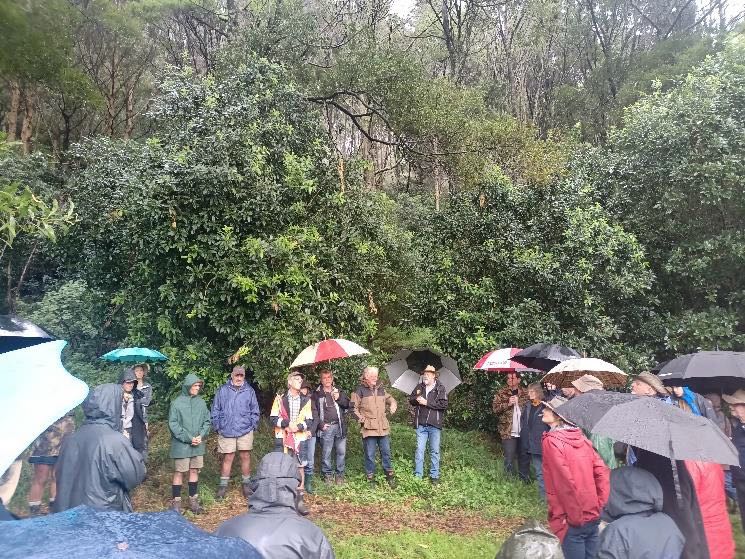
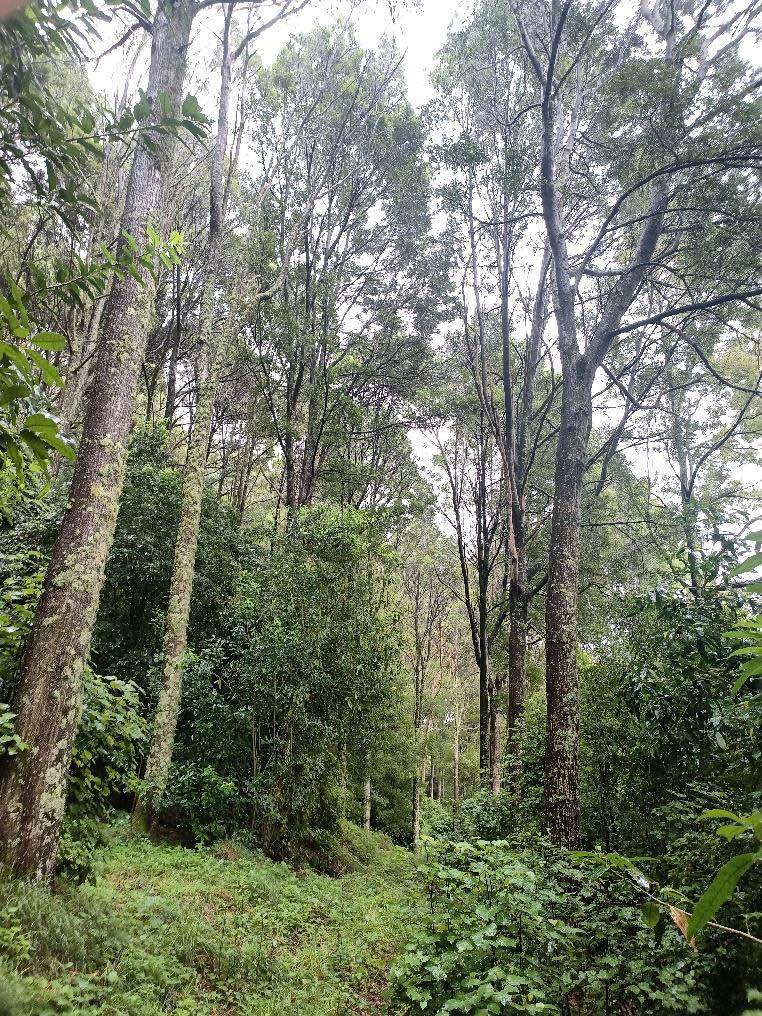
With some trepidation we headed up a very greasy track, thanks to the rain, to view the macrocarpa and harvesting practises.
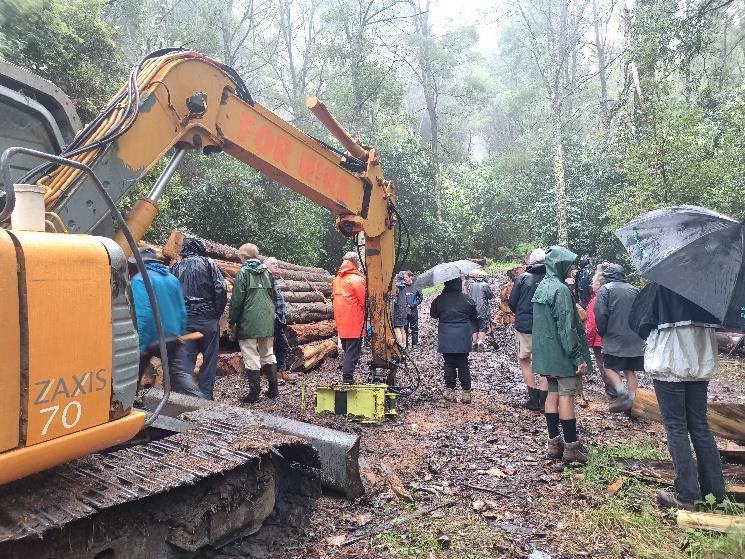
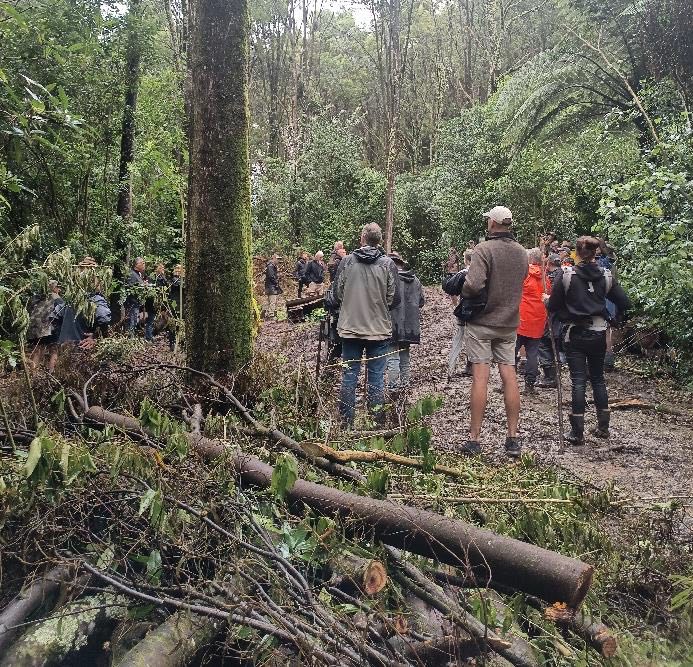
Although there was plenty of visible canker in the macrocarpa, I thought the pruned butt logs of harvested trees were quite impressive with good form and plenty of heart wood. It was a perfect spot to discuss all the woes of these species and amongst the 100 or more opinions of 50 farm foresters the following were common:
- Not a good cypress site, probably too warm and exposed, which tends to favour the canker fungi. Also noted that cypresses do require more fertility than the likes of radiata pine and there didn’t seem to be any firm opinions about what the next crop should be.
- The blackwoods had been very well pruned but Richard suggested they might have been better if they had been thinned as soon as pruning was finished to avoid the long branches in the crown which have suffered from wind damage. Richard’s other reservation that diameters were still a bit small.
- Harvesting in wide rows met with general approval but questions were asked about the prospects of getting re-establishment in a shaded environment with rampant mahoe growth. Richard said he was still open-minded about whether it was better to “top thin” the bigger trees or “bottom thin” the smaller. "Large diameter logs makes for better recovery of sawn timber and of course we are after heartwood so the outer wood is generally waste. We need to be ambitious – 60 cm plus diameters for the final crop".
- The production thinning had been done mainly with a small, 7 tonne excavator which had also been used for bunching and shovelling. There was some discussion about skidders and even forwarders, (8 wheel transporters), and the space/mess they might need/make, but again no dominant view.
- Regarding heart versus sap wood, some suggested the light sapwood of blackwoods contrasts nicely with the dark heart wood. Richard agreed but pointed out that lyctus borer just loves destroying sapwood.
- Another suggestion was that their natural durability should allow the macrocarpa logs, especially those from canker infested trees, to be felled and left in heaps, or perhaps even ring barked and left standing. Not everyone shared this faith in macrocarpa’s durability, or wind-firmness.
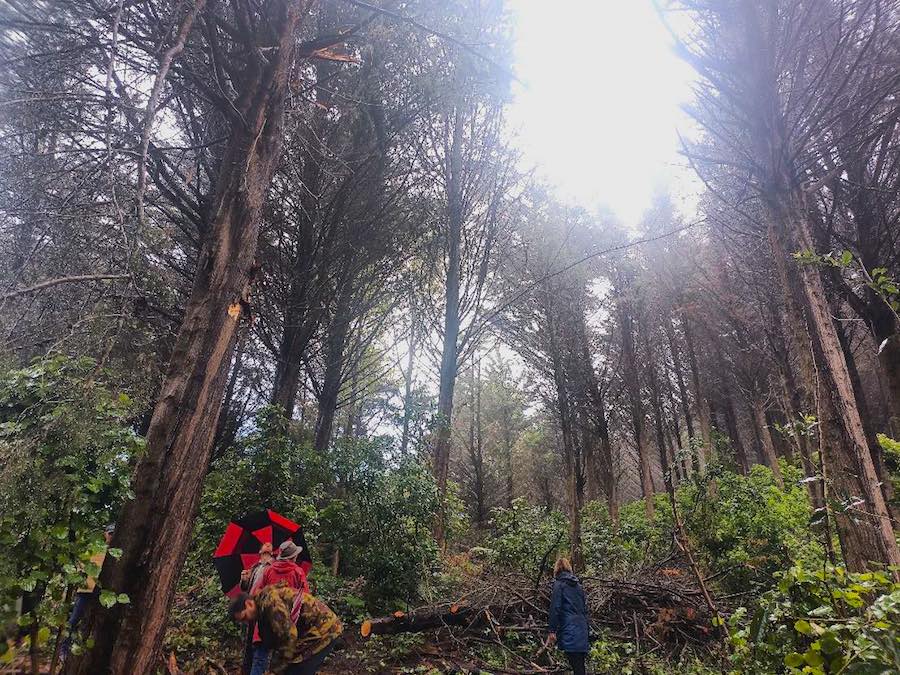
I think there was general agreement that this was a very well managed stand. Perhaps not an ideal site for either species but hard work and good timing has resulted in a very attractive little forest.
From Papaiti Forest it was a long convoy back to MacBlack’s milling and storage site at the old railway station site in George Street. There was some discussion on the comparative merits of sawing on site versus delivering logs to a centralised site.
Milling on site requires a versatile, attack anything type mill, such as the circular blade Lucas used by MacBlack, but these are not necessarily as efficient as other saws such as the horizontal band saws like the Wood-Mizer. There could also be issues in collecting sawn timber, where you needed a good match between load, ease of access and truck capacity. Vaughan Kearns, the other alternative timbers miller and supplier present left us in no doubt that he wants logs delivered to his Ruapehu Sawmills at Raetihi so that they can use the best sawing practise available there.
Regardless of the arguments, substantial amounts of timber are sawn on the George St site, and then fillet stacked under sheets of iron for air drying. The challenges of turning very mobile hardwoods into well behaved, stable flooring timber was discussed at length. Elm was the example discussed, but others such as the stack of Eucalyptus obliqua next door can also have the same habits, but at more modest levels. The larger boards from the initial sawing of elm need to be air dried and then kiln dried down to 10-12% moisture, before being re-sawn or dressed for installation as flooring. And the timber can twist, cup, bow, spring and split along the way. Not all timbers are equally bad and generally softwoods, i.e. conifer timbers, are better behaved.
Richard explained that their drying “kiln” was more a de-hydrator with de-humidifer and fans removing the humid air at around 35ºC.
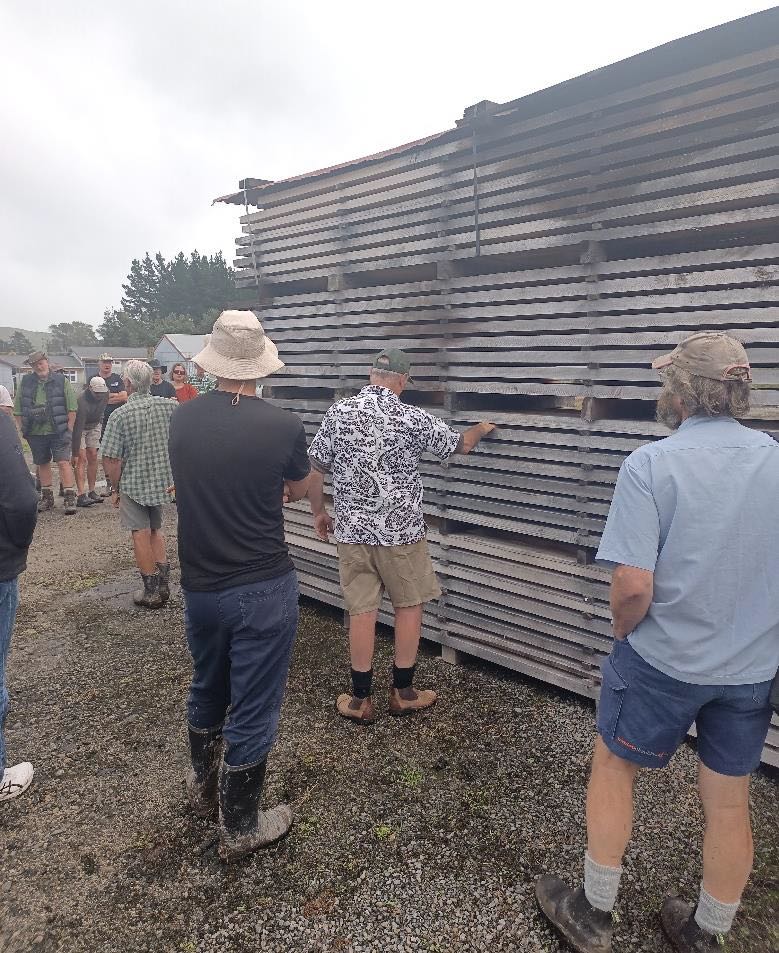
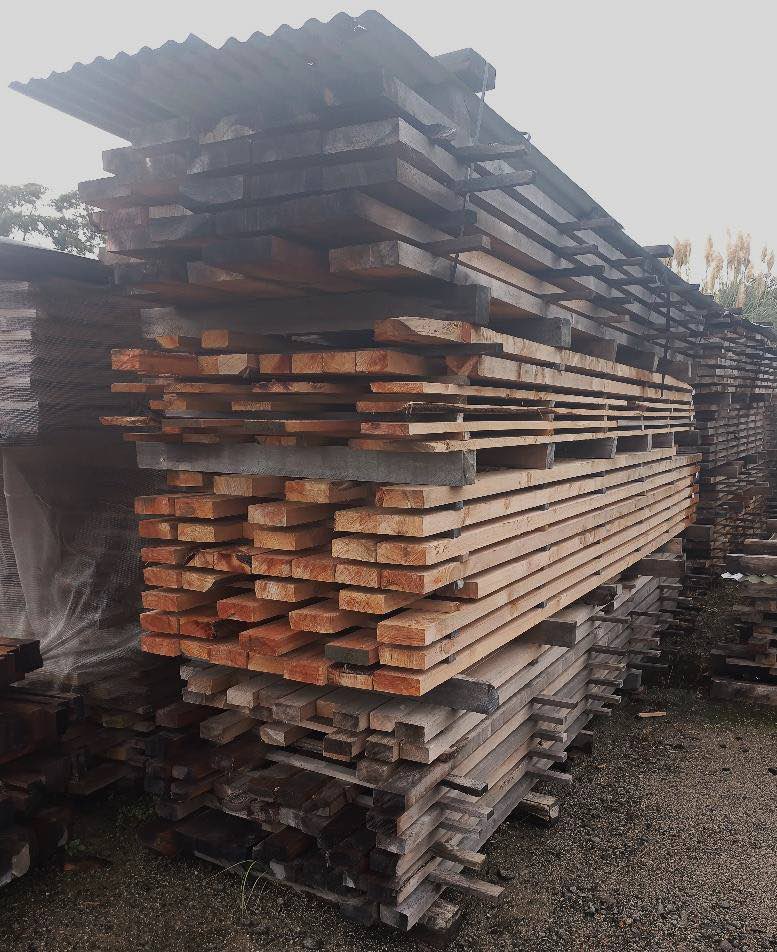
From George St it was on to MacBlack’s home base in Peat St. This has been steadily modified over the eight years since they started, with an impressive retail centre where a wide variety of timbers of different species and spec's are carefully sorted, labelled and stacked. Here Richard and Rachel Rose, now a part owner, discussed the issues, successes and failures of running such a business. They sell only locally grown, exotic timbers grown for timber, or perhaps shelter, and not natives that generally are components of ecosystems. There is one small exception; they do have a bit of totara. Nor do they sell imported timbers, though they had to think hard when offered some very saleable tropical hardwood from supposedly respectable origins. But no, this operation is part of growing and utilising sustainably alternative timbers.
The biggest problem according to Richard has been the cost of building adequate stocks of the range of timbers likely to be sought by customers. You can’t make a sale unless you have what they want, in adequate quantities, and they are likely to be looking for timbers for very different jobs and sometimes substantial volumes. There is no wholesaler at the end of a phone to deliver an extra 400 metres of blackwood 100 x 25 flooring timber if you run out. At the same time the grading scene is not well defined. Richard started with the NZFFA grading schedule but reality is more complicated than that. He showed us some very impressive macrocarpa beams, except that they had 1 cm black knots. Some people would be happy with them, some wouldn’t. Another problem can be the expectations of growers thinking they have the best macrocarpa logs in creation and expecting top prices for every board cut out of them. So building adequate stocks has been a slow and expensive process and explains why they haven’t delved more deeply into eucalypts, redwood, poplar etc. which are all present, but less publicised.
Mixed in with stock building are the problems of what is permitted in the building code. MacBlack supplies very little structural timber because everything, and not least most building consenters and inspectors are so deeply buried in the radiata code. Even Rachel and Hamish in their new house have had to retreat and accept radiata trusses. However decking and cladding are potential areas of conflict. Notably though they both spoke highly of some of the more wood orientated architects so there is hope.
There are other areas where bureaucracy likes to generate extra hurdles and costs. Richard gave us 2 examples: the dust removal systems and the means or otherwise of measuring efficacy in terms of employee health, and another demand for fire detector’s throughout the plant. These cost many thousands of dollars.
We moved on to see, from a safe distance, Wood-Mizer re-saws and 4-siders operated by one of the employees, Jake. I will not try to explain these machines except to say that they are necessary, expensive, and in the case of the 4-sider, notably unreliable. They produce the well-dressed boards that then go on to make the doors, benches, window frames, etc. which are wonderful examples of specialty timbers being used to best advantage. That was the last display of the day and a very encouraging one: the wood, the workmanship and the market all meeting in harmony.
So it was time to go home and digest what we had learnt from the day’s overload of information.
I have no hesitation in saying that this was one of the best field days I have attended and I offer my hearty congratulations to Richard and all his team for creating such a wonderful example of how to grow, process and utilise specialty woods: presenting the beauty, functionality and environmental benefits of specialty timbers. But we should remember that MacBlack is not the only alternative timbers outlet in our rohe. I mentioned Vaughan Kearns, with his Ruapehu Sawmills above, and he took a good constructive part in the day’s discussions. He runs a somewhat different model but we are very lucky to have both these outlets within range of most of our branch members.
Denis Hocking

 Farm Forestry New Zealand
Farm Forestry New Zealand